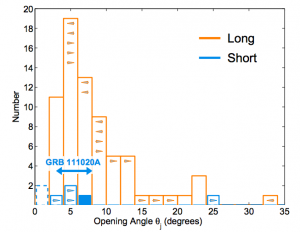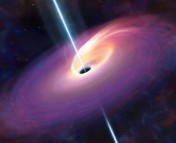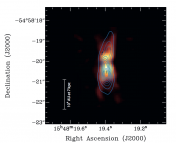Title: A Jet Break in the X-ray Light Curve of Short GRB 111020A: Implications for Energetics and Rates
Authors: W. Fong, E. Berger, R. Margutti, B. A. Zauderer, E. Troja, I. Czekala, R. Chornock, N. Gehrels, T. Sakamoto, D. B. Fox, P. Podsiadlowski
First Author’s Institution: Harvard-Smithsonian Center for Astrophysics
I am going to hazard a guess that when many of you think of Gamma-Ray Bursts (GRBs) you think of jets. However, I’m also going to hazard a guess that not all of you know why. There are some astrophysical contexts were we definitively see jets (e.g., the galaxy M87 and quasar 3C175 in the center and right panels below) but GRBs are not one of those cases. Rather, GRBs are simply short, intense, bursts of incredibly high-energy photons. If we interpret them as jets it is under the assumption that the jet is pointed directly towards us, and not because we have ever directly imaged a jet-like structure. And as it turns out, it’s tricky. Because we are only able to view any particular GRB from one angle, a short beam of gamma-rays from a spherical explosion and a short beam of gamma-rays from jet pointed directly towards Earth are indistinguishable…

left: artist's rendition of a GRB, including jets. middle: the jet in nearby galaxy M87 shown in optical (top) and radio (bottom). right: radio jet in quasar 3C175.
Despite being difficult to tell observationally, it clearly makes a HUGE difference theoretically whether GRBs are spherical or jet-like. Besides the obvious (if GRBs are jet-like you need an explosion mechanism that can create jets…), knowing the geometry of the explosion allows astronomers to constrain:
- The total energy released as gamma-rays. For a given pulse of light observed on Earth, the total energy released will be more if it is spherical rather than jet-like.
- The rate of GRBs in the universe. If GRBs are jet-like, then their true rate in the universe is much greater than their observed rate on Earth (we only see the ones pointed towards us).
Thus, astronomers would love to know just how jet-like GRBs really are. This is usually quantified in terms of the “opening-angle” of the explosion (the smaller the angle, the narrower the jet – see right). Fortunately, even though the 0.01 to 1000 second GRB itself offers little information on its geometry, it is possible to constrain its opening angle by looking for something known as a “jet break” in the longer wavelength afterglow that accompanies some GRBs. The authors of today’s paper do this for a recent short GRB: 111020A. Before we get into their results, however, we need a little background.
The Afterglow:
In addition to the initial, very short, burst of gamma-ray photons, some GRBs also possess longer wavelength counterparts which can last several days or more. These counterparts, which have been found in the X-ray, optical, infrared and radio, are referred to as the GRB afterglow. Most GRB afterglows have a spectrum characteristic of synchroton emission (although check out Nick’s astrobite on the Christmas Burst of 2010), and are thought to be formed when the explosion shock wave ploughs into material in the interstellar medium. When hit by the shock, this material is heated and accelerated up to relativistic speeds. If it then encounters a magnetic field, it will radiate synchrotron emission, creating the afterglow.
The “Jet Break”:
The afterglow is important for many reasons, one of which is simply that is allows us see emission, theoretically from either spherical or jet-like shock wave, for a much longer period of time. This, coupled with a neat effect from special relativity, allows astronomers to use afterglow emission to constrain the opening angle of any jet that may exist. Many of you will have heard of length contraction or time dilation, and there is another similar effect known as relativistic aberration or, more colloquially, relativistic beaming. This effect describes how if a light source is moving at relativistic speeds (as the shock wave from a gamma-ray burst is), no matter what direction the light is emitted, it will appear to an observer to be concentrated in a small angle in the direction of the motion of the source. The angle into which all of the light is “stuffed” is inversely proportional to the speed of the source – the faster it is moving, the smaller the angle.
So what does this have to do with the opening angle of GRB jets? At least part of the shock wave which powers the GRB afterglow is moving towards Earth at relativistic speeds and the emission is therefore “beamed” into a very small angle, also towards Earth. As time passes, the shock wave slows, the “beaming” is therefore reduced, and the afterglow emission should fade – with an essentially constant slope. If the shock wave were spherical, this would be the end of the story. However, if the shock wave is in the form of a jet, the slope of the fading will change (steepen) once the beaming angle is of comparable size to the jet angle. It is the steepening decline which is known as the “jet break”, and, if observed, one can relate the time of the break to the opening angle of the jet (a later break corresponds to a wider jet opening angle).
The trickiness of short GRBs:
This technique of identifying jet breaks in GRB afterglows has been used to constrain the opening angles for several dozen long-duration gamma-ray bursts. The resulting range of opening angles is 2 to 20 degrees with a median of 7 degrees, indicating that many long duration GRBs are, in fact, jet-like. However, to date, only a handful of short duration GRBs even have meaningful limits placed on their opening angles. One of the main reasons for this lack of information is that short GRB afterglows tend to be very faint. Indeed, of 70 Swift short GRBs in the past seven years only two have detected radio afterglows. Approximately 30% are detected in the optical, but these usually fade below the detection threshold for ground-based telescopes after ~1 day (too quickly to put meaningful constraints on the opening angle). Given our current understanding of GRB afterglows, the fact that many short GRB afterglows are faint or undetected indicates that there is very little material in the environment surrounding the burst.
Of the short GRBs that have possessed relatively bright afterglows, one was measured to have an opening angle of approximately 7 degrees, while another has a lower limit of 25 degrees (and thus, is potentially consistent with a spherical explosion). Hence, more information is needed to really constrain the nature of the explosions which produce short duration GRBs.
The results:
The authors of today’s paper examine the X-ray afterglow of short GRB 111020A. After compiling information from three different X-ray telescopes (Swift XRT, XMM-Newton and Chandra), they report the detection of a sharp steeping of the slope of the afterglow at approximately two days after the initial burst (see figure on left below). Based on both the timing of the break, and the large difference between the initial and final slopes the authors argue that the most logical interpretation of the feature is as a jet break (as opposed to, for instance, the “turning off” of the energy generation mechanism at early times which can also can a change in the slope of the afterglow light-curve).
Interpreted as a jet break, this feature implies an opening angle of 3 to 8 degrees. This, along with the 7 degree opening angle for another short burst mentioned above indicates that at least some short GRBs are very narrow or jet-like. In the figure on the right below, the authors show the distribution of constrained opening angles for both long (orange) and short (blue) GRBs. Although the information is very limited, it is possible that the distribution for short GRBs is consistent with that predicted by simulations of neutron star– neutron star or neutron star – black hole mergers (approximately 5 to 20+ degrees), which are the current leading theory for short GRBs. The author’s hope that with continued X-ray/mutli-wavelength follow-up at times greater than one day after the explosion they will be able to further constrain the distribution of opening-angles for short duration GRBs.








Trackbacks/Pingbacks